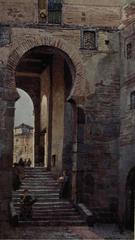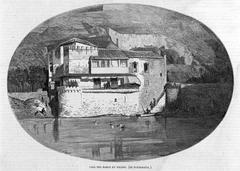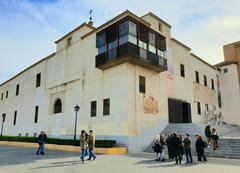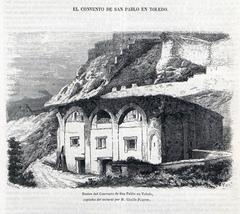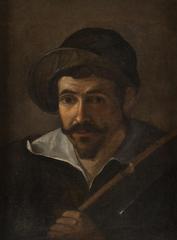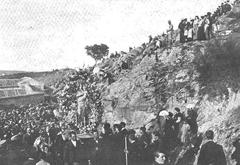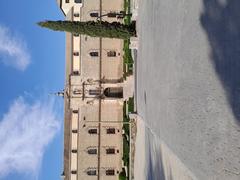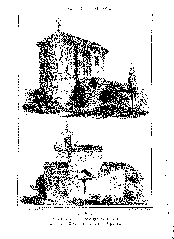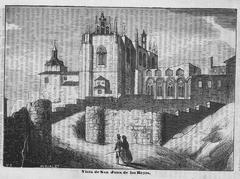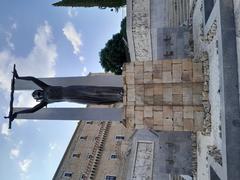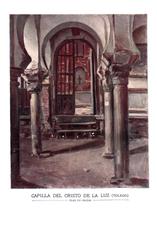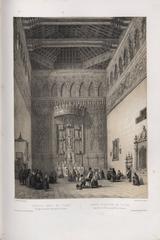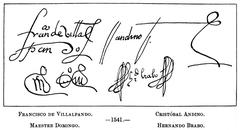Sinagoga Del Sofer: Visiting Hours, Tickets, and Toledo Jewish Heritage Guide
Date: 14/06/2025
Introduction
In the labyrinthine heart of Toledo’s historic Jewish Quarter, the Sinagoga Del Sofer stands as a testament to Spain’s rich Sephardic legacy. Though modest in its physical remains, this medieval synagogue—“Synagogue of the Scribe”—offers an intimate glimpse into the daily religious, educational, and communal life of the city’s Jewish community. Rediscovered through archaeological research and championed by historians like Jean Passini, the Sinagoga Del Sofer is a vital part of Toledo’s ongoing effort to honor its multicultural heritage and preserve its Jewish past (Toledo Sefarad).
This guide provides everything you need to know for visiting Sinagoga Del Sofer: historical context, practical visitor information, ticketing, accessibility, nearby attractions, and travel tips. Whether you are a history buff, cultural explorer, or descendant of Sephardic Jews, a visit to this site offers a meaningful journey into Toledo’s medieval Jewish heritage (Viajeros a Viajar).
Historical Background
Origins and Significance
Dating from the late 12th or early 13th century, Sinagoga Del Sofer is one of the oldest known Jewish places of worship in Toledo. Named after the “sofer,” or Torah scribe, the synagogue likely functioned as a center for prayer, Torah study, scribal activity, and community gatherings. Its existence illustrates the thriving spiritual and intellectual life that characterized Toledo’s Jewish community during the Middle Ages (Toledo Sefarad).
The Jewish Quarter: Urban Context
Medieval Toledo’s judería was a bustling enclave of narrow streets, fortified gates, and communal institutions including synagogues, study houses (madrisas), and ritual baths (mikva’ot). While grander synagogues such as El Tránsito and Santa María la Blanca are well-known, Sinagoga Del Sofer represents the smaller, neighborhood synagogues that were central to everyday Jewish life.
Decline and Rediscovery
The 1391 riots and the 1492 expulsion led to the decline of Toledo’s Jewish community, with many synagogues confiscated or destroyed. Sinagoga Del Sofer faded from memory until its archaeological rediscovery in the 20th century. Excavations revealed foundational walls, architectural fragments, and liturgical elements, now preserved beneath a protective platform for visitors to view (Viajeros a Viajar).
Visiting Sinagoga Del Sofer: Hours, Tickets, and Access
Location
Sinagoga Del Sofer is located in the Jewish Quarter, near Calle del Ángel and Calle de los Reyes Católicos, easily reached on foot from Toledo’s main attractions. Follow the “Ruta de la Judería” signage for a self-guided walk through the quarter.
Opening Hours
- Monday to Sunday: 10:00 AM – 6:00 PM (subject to seasonal adjustments and Jewish holidays)
- Closed on select Jewish holidays and for maintenance
Note: The site is accessed mainly through guided tours; solo entry is limited. Always verify current opening hours before planning your visit (Spain.info).
Tickets
- Individual Admission: €2–€4 (adults); discounts for students, seniors, and children
- Combined Tickets: Available for Jewish heritage sites, including El Tránsito and Santa María la Blanca
- Guided Tours: Typically €10–€25 per person, including several heritage stops
Tickets are best purchased in advance via official tourism offices or authorized online platforms. Onsite ticket sales may be limited.
Accessibility
Due to the site’s archaeological nature and the Jewish Quarter’s cobblestone streets, some areas may be challenging for visitors with reduced mobility. Contact the site or your tour provider in advance for specific accommodations.
Visitor Facilities
- Guided Tours: Available in Spanish and English; book ahead for availability.
- Restrooms: Nearby, but not always within the site.
- Gift Shop: Offers Judaica, books, and souvenirs reflecting Toledo’s Jewish legacy.
- Photography: Non-flash photography is generally allowed; check policies onsite.
What to See at Sinagoga Del Sofer
Architectural Features
- Foundational Remains: View original walls, flooring, and architectural fragments.
- Liturgical Elements: Discover niches for the Aron Kodesh (Torah ark) and evidence of a bimah (platform).
- Decorative Traces: Look for Hebrew inscriptions and geometric motifs characteristic of Sephardic synagogues.
Exhibitions & Interpretation
Guided tours provide insight into the synagogue’s dual role as a place of worship and study. Interpretive panels and displays detail the Jewish community’s history, the synagogue’s rediscovery, and its significance in medieval Toledo.
Cultural Events
Occasional lectures, workshops, and concerts are held at or near the site, especially during Jewish and local festivals. Check local listings for event details.
Visiting Tips
- Best Times: Visit on weekday mornings for fewer crowds. Consider attending during local festivals for a richer cultural experience.
- Dress Code: Modest attire is recommended; men may be asked to cover their heads as a sign of respect.
- Combine Visits: Include El Tránsito, Santa María la Blanca, and the Sephardic Museum for a comprehensive heritage tour.
- Footwear: Wear comfortable shoes suitable for uneven terrain.
- Safety: Toledo is generally safe, but remain attentive to personal belongings in busy areas.
Nearby Attractions in Toledo’s Jewish Heritage Circuit
- Synagogue of El Tránsito & Sephardic Museum: Renowned for Mudéjar architecture and Jewish history exhibits.
- Santa María la Blanca: A former synagogue featuring Islamic and Christian influences.
- Casa del Judío: A medieval home offering a window into daily Jewish life.
- Jewish Quarter Walk: Explore blue tile markers and symbols like the Menorah and “Jai” (life) embedded in the pavement.
Dining, Souvenirs, and Responsible Tourism
- Dining: The Jewish Quarter features cafés and restaurants with Castilian and kosher-inspired dishes. Reservations are suggested during weekends and holidays.
- Shopping: Find ceramics, silverwork, artifact reproductions, and Toledo’s signature marzipan.
- Sustainability: Respect historic sites by adhering to guidelines, minimizing disturbance, and supporting local businesses.
Frequently Asked Questions (FAQ)
Q: Can I visit Sinagoga Del Sofer independently?
A: Access is primarily through guided tours; independent visits are limited.
Q: Where do I buy tickets?
A: Purchase tickets through the official tourism office, authorized online platforms, or included with guided tours.
Q: Is the site accessible for visitors with reduced mobility?
A: Some areas present challenges; contact the site or tour provider for accessibility information.
Q: Are guided tours available in English?
A: Yes, tours are typically offered in Spanish and English.
Q: Can I take photographs inside?
A: Non-flash photography is generally permitted; confirm on arrival.
Plan Your Visit
For updated visiting hours, ticket information, and tours, consult these resources:
For maps, brochures, and updates, visit the Toledo Tourist Office or download the Audiala app for immersive, self-guided tours and event notifications.
Conclusion
Though modest in scale, Sinagoga Del Sofer is a cornerstone of Toledo’s Jewish heritage and a moving symbol of cultural resilience. Its preservation enriches the narrative of medieval Spain, inviting visitors to reflect on centuries of religious, intellectual, and intercultural exchange. Make the most of your visit by booking a guided tour, combining heritage sites, and engaging respectfully with this unique legacy.
For more travel tips, itineraries, and updates on Jewish heritage in Toledo, download the Audiala app and follow us on social media. Begin your journey into Toledo’s layered past today!
